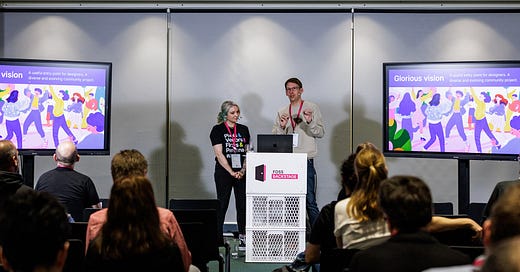Another 4 weeks have passed since the last update. It’s been two weeks of work, a week of holidays, and a week of conference & travel. The next two months will be much less travel, and I’m excited for a bit more routine and digging deep into a few projects.
Let’s start with the conference - FOSS Backstage. Like last year, it was super interesting to hear talks about the behind-the-scenes of open-source, and get to chat with many others who deal with organizational matters. Eriol and I presented the Open Design Guide. The problem it addresses seems to be well-recognized, since there were three other talks that talked about the difficulties of designers finding their ways into open-source. If we can improve these entry points, we’ll ideally see a lot more good design work happen overall - a rising tide. Let’s find out.
We’re properly kicking off planning for the Designathon, which is now combined with the accessibility day event. We have a timeline now, and next week will be about getting a basic website up and start getting the word out. This should make for a great community event and I hope we see a lot of different areas explored.
For the Bitcoin Design Guide, Mo and I are finalizing a plan for an interview series, where we speak with builders to learn about their design process, challenges and guide usage. That should ideally then help direct the next updates. Interviews are likely to happen throughout April. I hope everyone is excited as Tristan in the video below.
For the Bitcoin Core App, Johnny is heads down implementing the send and coin selection UI, with Michael and I providing support. We’re refining various interactive details, updating design docs, and updating the design system, so it’s all rock solid. It’s always surprising to me how much detail there can be in the send flow, and how intertwined some of the options get. I’m also iterating on the web prototype, which helps us more quickly validate some of the layouts and interactions in a dynamic environment before committing to them. Another aspect I am trying to wrap my head around still is writing a product strategy doc. Not so simple with this project, but an important artifact to have.
I also enjoyed this podcast about bitcoin payment UX with Conor and Stephen.
Recently, I also spent a moment thinking about how potential business models for lightning infrastructure (LSPs, really) might pan out. Will it be possible to hide all the channel and other costs behind transaction fees? Or will some of those be surfaced to users? If so, how? A monthly payment plan (like Alby has), or the occasional surprise charge based on usage?
Between that, and some of the points discussed in the podcast, the large question is what it takes for a new payment network to find broad adoption. It’s not just one factor or another, but a mix of…
Tech maturation - at first lightning did not have async payments, channel splicing, etc. It takes time to learn from practice how the network behaves and how it can be improved, and then make those developments.
Interoperability - mentioned in the podcast, you need the application layer to mature along with the tech. Often you have the chicken & egg problem. When new tech becomes mature enough to use it, and no one supports it yet, how do you roll it out across an ecosystem? Especially if no one is “responsible” for that, and different software teams have their own views and priorities? It’s like a free market in a way, where various dynamics decide how it pans out. In the end, it ideally “just works”.
Infrastructure - the bitcoin network has tens of thousands of nodes and a huge mining infrastructure, and the lightning network will have LSPs. Those take time to build out and optimize. Plus, we want to avoid centralization (I think I saw a stat that the top 10 lightning nodes have 84% of capacity, is that OK?). If (!) every user needs a node/channel, that is a huge amount of infrastructure (and liquidity).
Business models - bitcoin mining has been a volatile business, with miners regularly shutting down and new ones coming around. Can we expect the same with LSPs? They also need to make their businesses work. And some of this will be charged to users in one way or another.
Integration - bitcoin software does not live in its own world, and needs to be integrated with on/off ramps, payroll providers, etc. That is a big part of enabling the daily payment use case.
Social and cultural adoption - people need to get their heads around (some of) this and adjust their behavior (first we shape our tools, then our tools shape us, in good old Marshall McLuhan words). They will do that if they have a problem that this new network addresses. That takes time to learn, and it takes time to start trusting this new tech (it’s about money after all).
There’s probably more. And these factors are just as relevant for Ecash, Nostr, Ark, etc. It’s a quite complex mission, a messy process, and it takes a lot of different people and entities to make it happen. Best of luck to us, I suppose :)
Now, time to wrap up, prep for a planning call, and get this Monday moving.
Have a good one.
✌️🇺🇦





